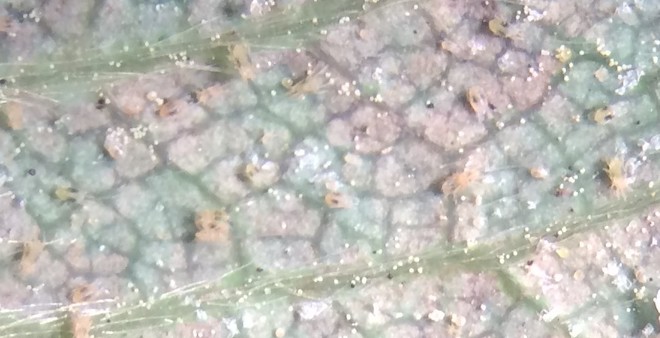Dec 2, 2021Early scouting for spider mites pays off
Spider mites may may seem insignifigant but they can cause extensive damage and reduce yields if not caught early in the season.
The two-spotted spider mite are very tiny (0.4 mm) and usually light yellow with a distinct spot on either side of the abdomen. The spider mites have piercing-sucking mouthparts that cause damage as they feed on the plant cells. This feeding usually occurs on the underside of the leaf making early detection more difficult. When populations are high you may also be able to find small clear spherical eggs on the underside of the leaves.
Low levels of infestation and feeding cause a slight stippled look to the upper leaf surface. As infestations grow the leaves become brittle with a bronze tint to them. Leaves can appear “dirty’ and may be covered with webbing.
arly detection is important since research has proven that even low numbers of mites can reduce yields. Strawberries can tolerate higher numbers of spider mites as the season progresses. At this time of the season the threshold for strawberries is 5 per leaflet, or 15 per leaf. As the season progresses the threshold moves up to 20 per leaflet. Treating an infestation too late may control the pest but will probably have little impact on yield.
There are several miticides on the market that work well on two-spotted spider mites. It is important to understand that some miticides are only effective on certain life stages. Using a product that is effective on eggs and juveniles will do no good if only adults are present. Growers should also check with their plant supplier to determine if miticides were applied in the nursery. If multiple applications of miticides are needed it is a good practice to rotate products with differing modes of action (MOA). Also unnecsessary applications of insecticides will almost always flare mite problems.
Since mites feed on the underside of the leaf, thorough coverage is critical. Application rates of 50 and 100 gallons of water per acre are not uncommon for controlling mites. There are some organically approved miticides and predatory mites have also proven effective. if you need assistance or recommendations contact your County Agent.
— UGA Extension; Photo at top: This level of mite damage will result in significant plant injury and loss. Photo: Shane Curry

















